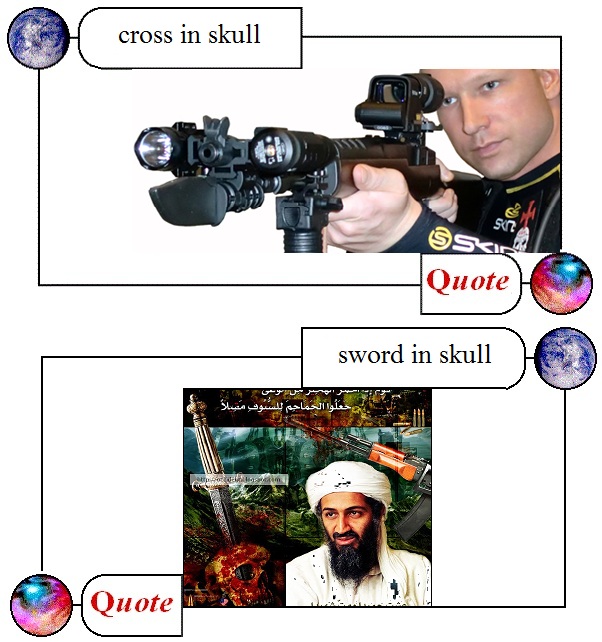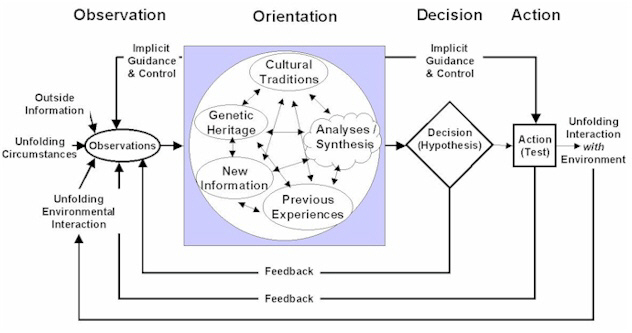Blog-friend John R. Hall is a Professor of Sociology at the University of California – Davis, and the author of such books as Gone from the Promised Land: Jonestown in American Cultural History; Apocalypse Observed: Religious Movements and Violence in North America, Europe, and Japan with Philip D. Schuyler and Sylvaine Trinh; and Apocalypse: From Antiquity to the Empire of Modernity. His current research involves deploying a social phenomenology to retheorize modernity in relation to contemporary society.
David Ronfeldt suggested that John’s long and detailed remarks taking off from my own post, 2083 Graphics – a first look, deserved to be a post in its own right and not be lost in the comments section, and with Zen’s approval, I am delighted to present it here as Dr Hall’s first Zenpundit guest-post. — Charles Cameron
___________________________________________________________________________________________
I have just completed a very preliminary examination of the Norwegian manifesto posted just before the Oslo bombings. It is an astonishing and significant document, far from the incoherent ravings of a mad person, as I would wish it to be. And it is incredibly chilling in its ruthless rationality and relative coherence. Here, I offer some initial reflections. I have concentrated on the portions from page 717 forward, where the author details ideology, revolutionary strategy, and utopian vision of a future, federated Europe. Beginning on p. 1388, the author offers an autobiography and c.v. of Breivik, which presumably will be checked out by investigators and the media, plus a quite detailed account of his actions over the past several years. A number of important comparisons already have been made – to al Qaida and the Oklahoma City bombing, for example. But in many ways, if the perpetrator indeed acted alone, he is something of a piece with the Unabomber, who similarly combined ruthless action with a carefully elaborated manifesto. There are important difference, to be sure. In particular, the Unabomber worked to conceal his identity so that he could carry out multiple actions, and he operated out of an environmental left ideology rather than a Christian nationalism.
The latter part of the document depicts its account of pre-emptive war as a new mode of writing, exploring scenarios rather than writing fiction or history, thereby claiming to eliminate its usefulness to authorities seeking to use it as evidence when bringing charges against the author or a perpetrator of the acts it describes.
As others already have commented, the label of ‘Christian fundamentalist’ seems wrong, at least in conventional use of the term today. Certainly the author represents himself as a nationalist/European federalist conservative opposed to ‘cultural genocide’ of the Enlightenment West, and seemingly he proposes reinstitution of monarchy as more representative of a nation than democracy can be. Only very late in the missive, p. 1134, does he embrace Europe’s return to the traditional Catholic Church, for its apostolic succession of authority and its capacity to guide believers in matters of scripture. This development is to be coupled with a re-initation of patriarchy, developed in substantial detail (p. 1141ff.), and concern about ‘the ongoing genocide of the Nordic tribes’ and a discussion of its genetic basis and the dangers of miscegenation and sexual promiscuity (including a discussion of ‘erotic capital,’ leading to a frank discussion of the possibility that the state could ‘play an essential role in national reproduction’ (p. 1157ff.; quote, p. 1185). The treatise goes on to mention future education, economic, pollution-control, population-control, crime, cultural/anti-multicultural, deportation, and youth policies, as well as discussing financing an organization, categories of traitors (A, B, and C). In short, it is a comprehensive (in Mannheim’s terms) ‘utopian’ vision, i.e., one that could never be realized in the world as it is presently institutionalized.
Yet there is certainly a basis for recognizing the claims of a ‘Christian’ basis for the ideology, and a religious fundamentalism as well. This latter claim, I make in relation to Martin Riesebrodt’s important comparative study of U.S. Protestantism at the dawn of the twentieth century and Iranian fundamentalism 70 years later or so – both of them strongly based in an ideology of patriarchy, as is the Oslo killer’s manifesto (A Pious Passion, U. California Press, 1993).
Yet this is not simply ideological quasi-religious fundamentalism/nationalism. Rather, the utopian program has all the markings of an apocalyptic crusader, and more generally, the apocalyptic warring sect that I described in Apocalypse (Polity, 2009). The lever by which the author makes contact with Christianity (beyond its status as the cultural basis of European civilization, is a modern-day ‘PCCTS, Knights Templar’ struggle to initiate a European ‘civil war’ against ‘enablers’ – cultural marxists and multiculturalists who are ‘aiding and abetting’ cultural genocide, most significantly in efforts to accommodate Islam within Europe. The challenge, as the author sees it, seems to be to eliminate Islamic migration to Europe, assimilate or force emigration of Muslims, and to excise all Islamist or Arab influenced culture, art, and architecture from European countries. The Knights Templar, described as an ‘ancient Christian European military order,’ is being re-founded not by Christians alone, but by 12 individuals, including a ‘Christian atheist’ and a ‘Christian agnostic.’ Eventually, p. 1309, the manifesto is clear that its appeal is to ‘cultural Christians,’ although it invokes the Bible and Church crusading history, especially the work of Bernard de Clairvaux, to justify the contemporary initiative. One of many elements is the crucial proposal to engage in asymmetric warfare – a vein that is classically that of the apocalyptic warring sect, using a ‘clandestine cell organization,’ combining the rhetoric of ultimate belief in a cause with the cold, rational logic of how to operate. In considerable detail, the manifesto outlines a mode of operations that foreshadows the actions in and near Oslo, including the chilling note, page 886, that it will take ‘the SWAT team 10 – 40 minutes to reach you,’ and therefore, it is worthwhile to divide up the components of a planned action accordingly.Similarly, the author mentions, p. 995, ‘announcing your operation’ ‘only seconds before you initiate’ it, and suggests, p. 927, ‘hide a knife behind a smile,’ a recommendation, along with subsequent ones, that foreshadows the killer’s use of a police uniform and a story about helping to ensure the safety of the island camp participants before beginning to slay them – a technique that he used twice, in different places on the island.
In a variety of passages, the document offers a detailed handbook of asymmetric operations of war, including attacks and sabotage, and evaluation of a variety of targets, accompanied by a detailed catalogue of equipment, weapons (including bombs made from fertilizer – see esp. p. 1015), and armor, where to buy materials, and how to create weapons, detailed discussions of chemical, biological assaults, and attacks on nuclear reactors, as well as dietary recommendations, and an outline of a training regimen, recommendations concerning alliances with certain criminal networks [a theme that reprises the analysis of Eric Hobsbawm that I cited several weeks ago].
The author also announces that the apprehension of a Knights Templar is not the end of the operation: it ‘will mark the initiation of the propaganda phase’ (p. 948), and afterward, the task will be one of ‘countering the misinformation campaign’ (p. 1073), and comments on the use of trial opening and concluding statements for propaganda purposes (p. 1108-14). Alternatively, if you die, you will live on as a martyr in the memory of those carrying on the cause.
The scope of the publication is almost encyclopedic. It also includes historical analysis of how the past millennium of European history lead to the present crisis and need for re-formation of the Knights Templar, as well as a sketch of the umbrella organization, membership, military uniforms for dress occasions, medals, appropriate tombstones, a proposal for subsequent compensation (upon victory) for people who contribute to the resistance movement (a sort of rational-choice approach to mobilizing supporters), and on and on.
In short, the document envisions apocalyptic war as the means to reach a new European conservative/nationalist/Christian utopia. Yet unlike many other visions of apocalyptic war, this manifesto goes far toward detailing what that utopian world would look like. Even if, as it seems, this action is that of a lone individual, it is a dangerous development that we ignore at our peril.
John Hall






 make for an exciting action film. Or perhaps a series of films along the lines of The Bourne Identity or those Tom Clancy movies with Harrison Ford. All well and good. But that is not why The Profession is worth reading – that’s merely why it is fun to read.
make for an exciting action film. Or perhaps a series of films along the lines of The Bourne Identity or those Tom Clancy movies with Harrison Ford. All well and good. But that is not why The Profession is worth reading – that’s merely why it is fun to read.

